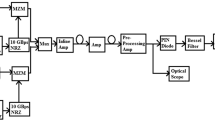Abstract
In all optical backbone networks, the introduction of Ultra Long Haul (ulh) optical systems associated with Optical Add Drop Multiplexers (oadm) gives rise to new network architectures and also to new engineering constraints, because signals suffer effects which do not exist in networks today. The purpose of this paper is to study, through numerical simulations, the impact on the signal brought by the concatenation of oadms. It is usually predicted that the transmission quality is severely degraded by filtering effects. However, the simulations show that by introducing for example a small amount of non-linearities, degradations do not obligatorily happen.
So as to highlight the effects of some parameters, we have built, in the simulation tool, different components having particular properties to vary amplitude, frequency and phase of filter group delay ripple. We show how in some circumstances, the eye widens due to cross phase modulation reduction or due to the interplay between chromatic dispersion and non-linear effects.
Résumé
Dans les réseaux dorsaux entièrement optiques, l’introduction des systèmes à très longue portée (ulh) associés aux multiplexeurs à insertion-extraction optique (mieo) conduit à de nouvelles architectures et à de nouvelles contraintes en matière d’ingénierie, parce que le signal subit des effets qui n’existent pas dans les réseaux actuels. L’objectif de cette communication est d’étudier, grâce à des simulations, l’impact que peut avoir une cascade de mieo sur le signal dans un lien d’un réseau tout optique. Il est couramment admis que l’introduction de tels composants ne peut que dégrader la qualité de la transmission. Or les simulations montrent qu’en introduisant par exemple une part raisonnable de non-linéarités, la mise en cascade de mieo contenant des filtres dans une liaison ne produit pas obligatoirement une dégradation des performances.
Pour mettre en évidence l’effet des différents paramètres des filtres, nous avons construit dans le simulateur utilisé des composants ayant des caractéristiques particulières afin de faire varier les paramètres des ondulations du temps de groupe, amplitude, fréquence et phase. Nous montrons comment, dans certaines conditions, l’ouverture de l’œil s’améliore grâce à la réduction de la modulation de phase croisée ou à l’interaction entre la dispersion chromatique et les effets non linéaires.
Similar content being viewed by others
References
Gnauck A.H., Winzer P. J., Chandrasekhar S., “Hybrid 10/40-G transmission on a 50-GHz grid through 2800 km of SSMF and seven optical add-drops”, IEEE Photon. Technol. Lett., 17, no 10, pp. 2203–2205, Oct. 2005.
Birk M., Skolnick C., Curto B., Marlieb R., Schmidt T. J., SAUNDERS R., ZECH H., SCHUCHT H. M., HEINRICH J., WIESKE C. J.), “Field trial of a 40 Gbit/s PSBT channel upgrade to an installed 1700 km 10 Gbit/s system”, Proc. OFC2005, Anaheim, CA, 2005, Paper OtuH3
Joindot I., “Dispersion Map Optimization in Hybrid Raman/Erbium-Doped Fiber Amplifier-Based 40-Gb/s Link”, IEEE Photon. Technol. Lett., 17, no 7, pp. 1555–1557, Jul. 2005.
Frignac Y., Antona J-C., Bigo S., “Enhanced analytical engineering rule for fast optimization of dispersion maps in 40 Gbit/s-based transmission systems”, Proc. OFC2004, Los Angeles, CA, 2004, Paper TuN3.
Pennincks D., Chbat M., Pierre L., Thiery J-P), “The phase-shaped binary transmission (PSBT): a new technique to transmit far beyond the chromatic dispersion limit”, IEEE Photon. Technol. Lett., 9, no 2, pp. 259–261, Feb. 1997.
Kaiser W., Wuth T., Wichers M., Rosenkranz W., “Reduced complexity optical duobinary 10-Gb/s transmitter setup resulting in an increased transmission distance”, IEEE Photon. Technol. Lett., 13, no 8, pp. 884–886, Aug. 2001.
Charlet G., Antona J-C., Lanne S., Bigo S., “From 2.100 km to 2.700 km distance using phase-shaped binary transmission at 6.3 Tbit/s capacity”, Proc. OFC2003, Atlanta, GA, 2003, Paper we3.
Zheng X., Liu F, Jeppesen P., “Receiver optimization for 40-Gb/s optical duobinary signal”, IEEE Photon. Technol. Lett., 13, no 7, pp. 744–746, Jul. 2001.
Tzanakaki A., Zacharopoulos I., Parcharidou D., Tomkos I., “Nonlinear penalty suppression in cascades of optical add-drop multiplexers”, IEEE Photon. Technol. Lett., 17, no 12, pp. 2769–2771, Dec. 2005.
Nielsen T. N., Eggleton B. J., Strasser T. A., “Penalties associated with group delay imperfections for NRZ, RZ and duo-binary optical signals”, Proc. ECOC’99, pp. 1388–1389.
Liu X., Mollenauer F., Wei X., “Impact of groupe-delay ripple in transmission systems including phase-modulated formats”, IEEE Photon. Technol Lett., 16, no 1, pp. 305–307, Jan. 2004.
Scheerer C., Glingener C., Fischer G., Bohn M., Rosenkrank W., “Influence of filter group delay ripples on system performance”, Proc. ECOC’99, pp. 410–411.
Dingel B. B., Izutsu M., “Multifunction optical filter with Michelson-Gires-Tournois interferometer for wavelength-division-multiplexed network system applications”, Optics Letters, 23, no 14, pp. 1099–1101, Jul. 1995.
Liu X., «Can 40-Gb/s duobinary signals be carried over transparent DWDM systems with 50-GHz channel spacing?,» IEEE Photon. Technol. Lett., 17, no 6, pp. 1328–1330, Jun. 2005.
Bissessur H., Bastide C., Hugbart A., “Performance characterization of components with phase ripple for different 40 Gb/s formats”, Proc. OFC2006, Anaheim, CA, 2006, Paper OFN4.
Zhu L., Chen M., Zhang Y., Xie S. “Impacts of cascaded filters with group delay rupples on 40-Gb/s WDM transmission system”, IEEE Photon. Technol. Lett., 14, no 11, pp. 1518–1520, Nov. 2002.
Additional information
The authors were with France Télécom, division R&D — Technopole Anticipa, 22307 Lannion, France up to 12/31/2006.
Rights and permissions
About this article
Cite this article
Joindot, I., Joindot, M. Impact of cascaded filters-based OADMs in an all optical backbone network/Influence des multiplexeurs d’insertion-extraction optiques, fondés sur des filtres en cascade, sur un réseau dorsal entièrement optique. Ann. Telecommun. 62, 550–566 (2007). https://doi.org/10.1007/BF03253276
Received:
Accepted:
Issue Date:
DOI: https://doi.org/10.1007/BF03253276
Key words
- Optical communication
- Wide area network
- Optical multiplexer
- Cascade arrangement
- Numerical simulation
- Non linear effect
- Wavelength division multiplexing
- Binary modulation
- Group delay
- Optical filter
- All optical technology




